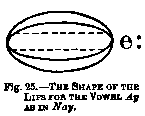Voice Training In Speech And Song - online tutorial
The Structure And Use Of The Vocal Organs, And The Means Of Securing Distinct Articulation.
| Share page | Visit Us On FB |
|
50 |
THE VOWEL SOUNDS. |
||
|
the lips are nearly parallel and the corners are almost obliterated.
Gnat.—Scarcely any alteration in the position is required except that the tongue is slightly raised. The Northern English pronunciation of this sound is represented by the phonetic sign a and seems to be an intermediate sound between a: and ae ; by many phoneticians a is said to form the first part of the diphthongs I and ou. For a the tongue must not be raised.
Hurrah ! hurrah ! a single field hath turned the chance of war; Hurrah ! hurrah ! for Ivry, and King Henry of Navarre !
Sometimes a troop of damsels glad, An ahbot on an ambling pad; Sometimes a curly shepherd lad, Or long-haired page in crimson clad. |
|||
|
64. The Vowel Ay (e:) and its subordinate e (e).
Nay.—The chief difficulties in the production of this sound are usually due to the tongue position required. The front of the tongue has to be raised, so that its sides touch the side teeth; the tongue may become rigid and  the tone accordingly hard. To overcome the hardness of tone, first of all do not raise the tongue more than is absolutely necessary. In passing from the Ah to the Ay position, raise the lower jaw so that the teeth are separated by a third of an inch for Ay, instead of an inch as required for Ah; this brings up the tongue a long way without causing the tongue muscles to contract. While the tongue the tone accordingly hard. To overcome the hardness of tone, first of all do not raise the tongue more than is absolutely necessary. In passing from the Ah to the Ay position, raise the lower jaw so that the teeth are separated by a third of an inch for Ay, instead of an inch as required for Ah; this brings up the tongue a long way without causing the tongue muscles to contract. While the tongue |
|||